China’s top 10 Important Archaeological Discoveries for 2013 Announced
From:Chinese Archaeology NetWriter:Date:2014-04-11
After one and a half days of presentations and voting by the 21-judge panel, the top 10 important archaeological discoveries in 2013 were announced in Beijing on 9th April 2014. The State Administration of Cultural Heritage, China Cultural Relics News and China Archaeological Society jointly held a press conference announcing the result.
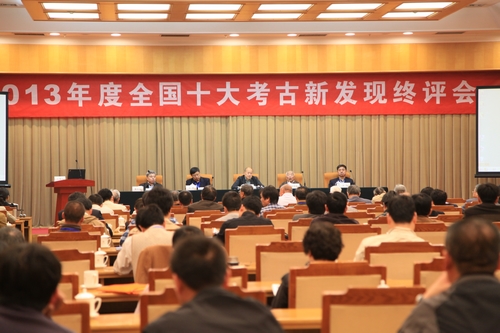
Meeting locale
1. Shigushan Tomb of Western Zhou Dynasty (c. 11th century-771 BC), Baoji, Shaanxi province
Totally 230 pieces (sets) burial offerings were unearthed from 15 burials in the cemetery, including 92 bronze ritual vessels with inscriptions and clan symbols. Some of the vessels, such as the fu vessel found in burial M4 are important for the establishment of a finer chronological framework of Western Zhou remains.
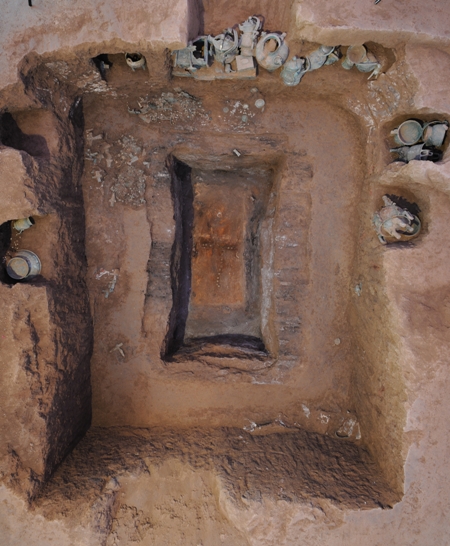
chamber of burial M3
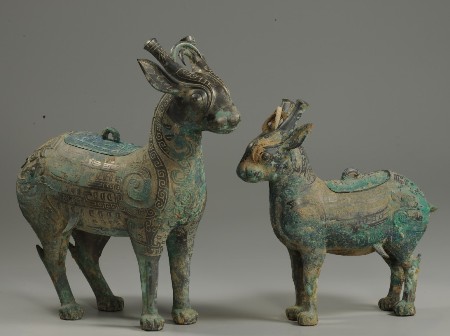
animal shaped zun vessel
2. Wenfengta cemetery of Eastern Zhou Dynasty (770-256 BC), Suizhou, Hubei province
The Wenfengta cemetery is the burial ground of the Zeng State of the Eastern Zhou Dynasty. By present, about 70 burials, including the burial of Duke Bing of Zeng State, had been discovered, together with more than 1000 pieces (sets) of burial offerings including bronze ding tripods, fu vessels, gui vessels, pots, fou vessels, yan vessels, jian basins, plates, and yi vessels, some of which with the inscription of Zeng, Zengzi, and Zenggongzi. Two chariot pits were also found. These discoveries are important for the research on the history of the Zeng State.
More details:http://www.kaogu.cn/html/en/Special_Events/Archaeology_Forum_2013/2014/0116/45032.html
More details:http://www.kaogu.cn/html/en/Special_Events/Archaeology_Forum_2013/2014/0116/45032.html

bronze lamp

inscription sui随 on a bronze vessel
3. Jiwanggu Burials of Spring and Autumn Period (770-476 BC), Yishui, Shandong province
Two burials dating to late Middle Spring and Autumn period were found at the Jiwanggu hill, both having a shaft dug into the rock. Burial M1 has a passage, a main chamber and a special chamber for a chariot and horses. M2 is in fact a unfinished burial, leaving some important traces for the understanding of burial construction process. The two burials are important for the research on local history of the Yi River valley during the Spring and Autumn period.
More details:http://www.kaogu.cn/html/en/News/New_discoveries/2014/0407/45776.html
More details:http://www.kaogu.cn/html/en/News/New_discoveries/2014/0407/45776.html
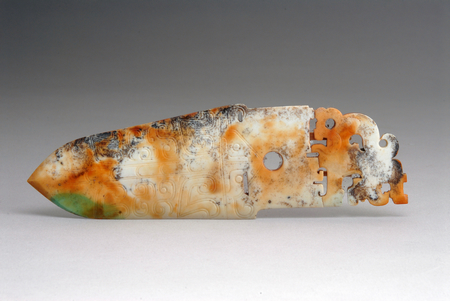
jade ge dager
4. Tuzishan site, from Warring States Period (475-221 BC) to Wu State (AD 220-280) of the Three Kingdoms Period, Yiyang, Hunan province
The most astonishing discovery at the Tuzishan site is the archives written on about 15,000 pieces of wooden slips found in 16 wells. The archives record the population size, agricultural fields, property, tax and legal cases of the Chu State in the Warring States period, Qin Dynasty, Zhangchu period, Western Han Dynasty, Eastern Han Dynasty, and the Wu State in Three States period. The artifacts of the Zhangchu State established by the rebels in the late Qin Dynasty were extremely valuable.
More details:http://www.kaogu.cn/html/en/News/New_discoveries/2014/0422/45938.html
More details:http://www.kaogu.cn/html/en/News/New_discoveries/2014/0422/45938.html

proclamation of the Second Emperor of the Qin Dynasty
5. Laoguanshan cemetery of Western Han Dynasty (206 BC-AD 24), Chengdu, Sichuan province
In the Han Dynasty Laoguanshan cemetery, archaeologists unearthed four burials with a large number of lacquer objects and pottery, and some bronze objects, jade objects and iron objects. The medical books in the name of Bianqu – a legendary doctor recorded in ancient texts – on bamboo slips in burial M1, a human figurine with acupuncture points in burial M3 and a bamboo model of a loom in burial M2 are rare and very valuable discoveries.
More details:http://www.kaogu.cn/html/en/Special_Events/Archaeology_Forum_2013/2014/0116/45038.html
More details:http://www.kaogu.cn/html/en/Special_Events/Archaeology_Forum_2013/2014/0116/45038.html
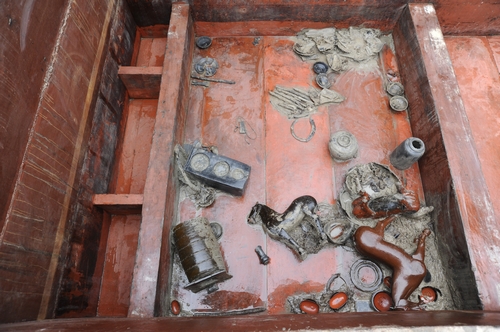
artifacts distributed in the southern chamber of M2
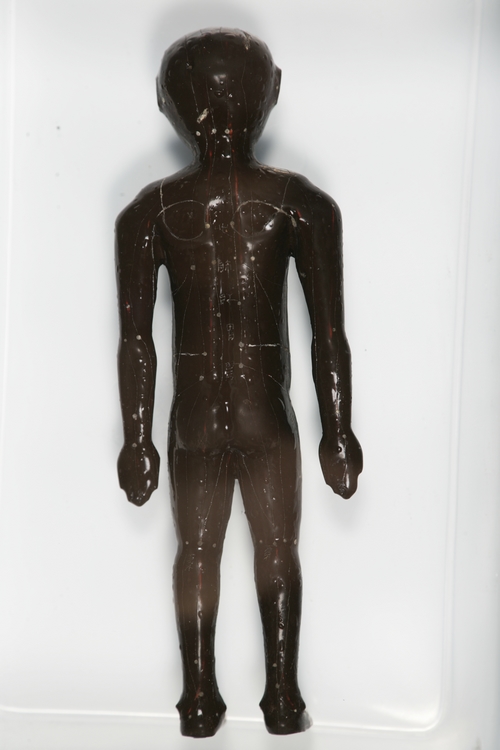
the figurine with acupuncture points in burial M3
6. Hanguguan military pass of Eastern Han Dynasty (AD 25-220), Luoyang, Henan province
The first discovery of remains of the Hanguguan Pass of the Han dynasty dated back to 2100 years ago. It had been always an important part of the defense system for Luoyang basin and surrounding areas. In order to cope with the application for the lists of world cultural heritage, survey and excavation of the ruins of Hanguguan has been formally carried out in 2013. A small walled town, roads and building remains were unearthed. The ancient road going through the pass was the only route connecting the east and the west. The discovery of Hanguguan Pass is of high academic value, providing vital materials for the research of passes in Qin and Han Dynasties and significant evidences for the protection of Hangu Pass ruins as well as Silk Road’s application for the world cultural heritage status.
More details:http://www.kaogu.cn/html/en/News/New_discoveries/2014/0425/45972.html
More details:http://www.kaogu.cn/html/en/News/New_discoveries/2014/0425/45972.html

a brick with the in inscription guan 关
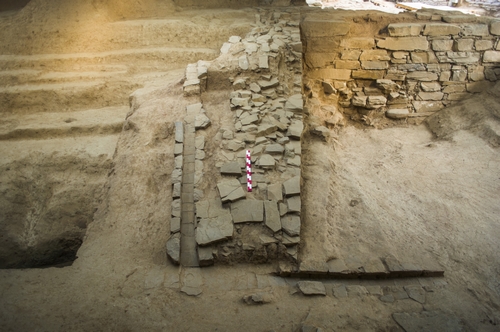
the horse passage at the eastern wall
7. Weiqiao bridges of Western Han Dynasty (206 BC-AD 24) to Eastern Han Dynasty (AD 25-220), Xi'an, Shaanxi province
Seven ancient bridges were found on the Wei River during the excavation by the Shannxi Provincial Institute of Archaeology, the Institute of Archaeology CASS and the Xi’an City Institute of Cultural Heritage Preservation. The bridge No.1 outside the Chuchengmen gate of the Han capital city Chang’an is more than 880 m in length. Carbon dating dates of the wooden posts of the bridge are between 380BC and 330AD. These discoveries are important not only for the research of early bridge building history, but also for the reconstruction of courses change of the Wei River.
More details:http://www.kaogu.cn/html/en/Special_Events/Archaeology_Forum_2013/2014/0116/45034.html
More details:http://www.kaogu.cn/html/en/Special_Events/Archaeology_Forum_2013/2014/0116/45034.html
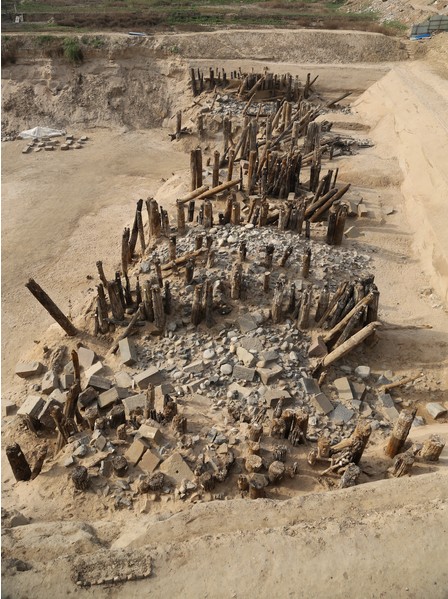
One of the bridge facing the Chucheng Gate of the Han capital Chang’an city
8. Tomb of Emperor Yang of the Sui Dynasty (AD 581-618) at CaoZhuang in Yangzhou, Jiangsu
The tomb is a large earth mound 49 m long from east to west and 48 m wide from south to north. Under the mound, two burials were discovered. A stone memorial tablet with the inscription “Sui gu Yangdi (past Emperor Yang of the Sui Dynasty)” was found in burial M1. M1 is 19.5 m in length, 5.9 to 6.42 m in width and consists of a passage, a doorway, the eastern side room, the western side room and the main chamber. The nearly 200 pieces (sets) of burials offerings include a finely made diexie decorated belt, indicating the high status of the deceased. The female deceased in burial M2 under the same mound might be the queen of Emperor Yang. These discoveries provide important details of the mysterious death of the emperor.
More details:http://www.kaogu.cn/html/en/Special_Events/Archaeology_Forum_2013/2014/0128/45186.html
More details:http://www.kaogu.cn/html/en/Special_Events/Archaeology_Forum_2013/2014/0128/45186.html
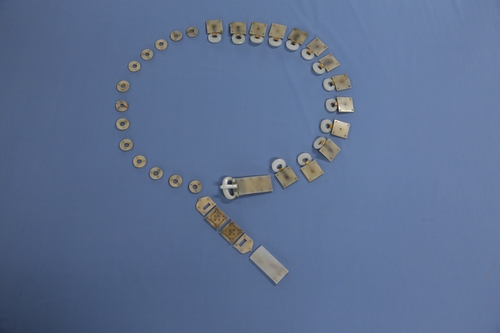
dexie belt with gold and jade decoration
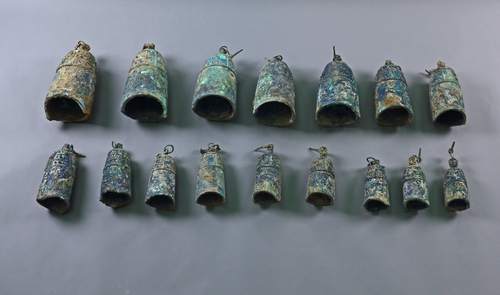
bronze bell set
9. Shiqu rock engravings of Tubo Kingdom (7th to 9th century), Shiqu county, Sichuan province
From 2010 to 2013 the Sichuan Provincial Institute of Cultural Relics and Archaeology and the Cultural Bureau of Shiqu County in Ganzi Prefecture have conducted a joint investigation to the early engravings in Shiqu County, Sichuan province. Successively three stone inscriptions remains including 18 units have been found respectively on the Xuba Holy Mountain, on the Baima Holy Mountain and in the Yanjiaocun village, which are indeed important achievements. The carvings are in good state of conservation, covering a rich variety of motifs including images of the Five Buddhas, Vairocana, Bodhisattvas, Tara and ancient Tibetan inscriptions, which are basically prevalent motifs of the Tubo period. The discovery is also important for the research on ancient transportation roads between the Tang Empire and Tibet.
More details:http://www.kaogu.cn/html/en/News/New_discoveries/2014/0128/45184.html
More details:http://www.kaogu.cn/html/en/News/New_discoveries/2014/0128/45184.html
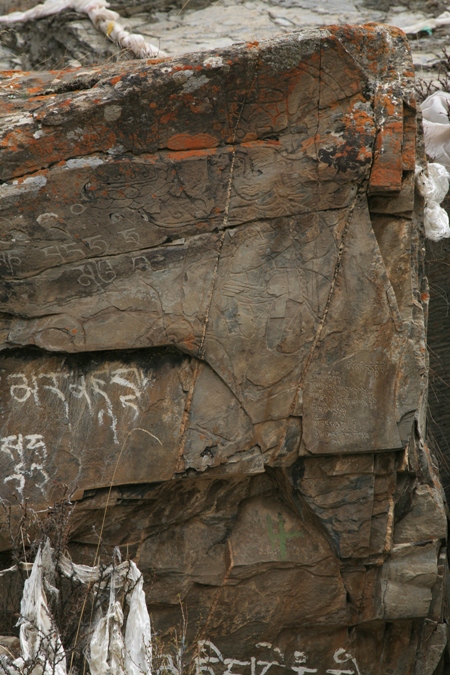
the first engraving at Xuba Holy Mountain
10. Nanyao porcelain kilns of Tang Dynasty (AD 608-917), Jingdezhen, Jiangxi province
Two long “dragon kilns” were found at the site, together with several dozens tons of porcelain sherds. The celadon of the kilns is really characteristic, with some similarities with the Changsha kilns, the Hongzhou kilns, the Yue kilns and the Lushan kilns. The kilns are by present the earliest remains of porcelain industry at Jingdezheng, which became the “capital of porcelain” in China in the later historic time.
More details:http://www.kaogu.cn/html/en/News/New_discoveries/2014/0430/46028.html
More details:http://www.kaogu.cn/html/en/News/New_discoveries/2014/0430/46028.html

dark glazed waist drum
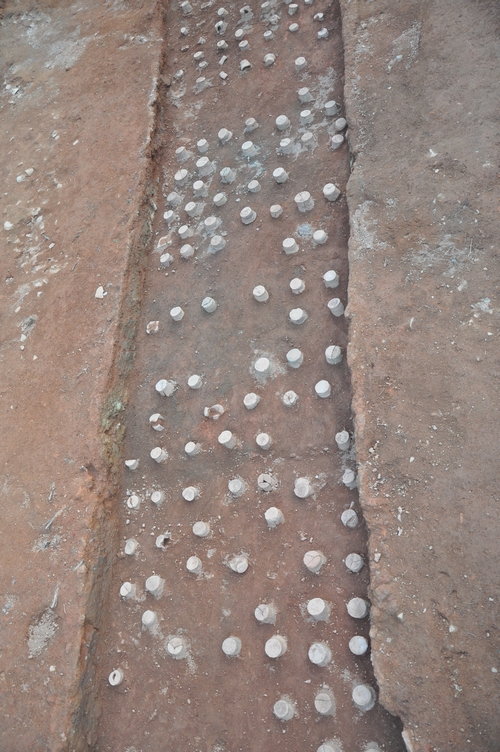
supporters found in a longyao “dragon kiln”
The top 10 important archaeological discoveries for 2013 were selected from a pool of more than 600 archaeological excavations conducted last year. The time period ranges from the West Zhou period to the Tang dynasty. The sites are from 9 provinces. Noticeably, there is an increase in the number of sites in the frontier regions, which well indicates the balanced development in archaeological excavations and researches. These 10 discoveries cover a rich variety of sites, ranging from the cemetery, kiln, Buddhist remains and military pass, some of them are relatively rare archaeological findings. These discoveries provide crucial information and bring new perspective to academic research.
After 23 years, the selection of the top 10 important archaeological discoveries has become an important platform to introduce new archaeological researches to both the academic circle and the public.

